Key Takeaways:
A detailed study of the dynamics of the Dawn spacecraft as it orbits the large non-spherical asteroid Vesta next summer reveals one of the most complex operational environments for a NASA mission to date. This work has implications for future mission planning to other large asteroids.
The Dawn spacecraft is using an efficient ion-propulsion system that enables it to make the first ever double rendezvous. After completing its study of Vesta, Dawn will depart and orbit the dwarf planet Ceres in 2015.
Ion propulsion generates gentle acceleration over long periods of time, in contrast with chemical propulsion that produces high thrust over short periods of time, said Pasquale Tricarico from the Planetary Science Institute in Tucson, Arizona. Dawn currently uses this system to provide propulsion for its voyage to Vesta. Ion propulsion will also be used to slowly transit from high to low mapping orbits. Close passes are expected to reveal the dramatic surface of what was a planetary embryo, including the crater from a giant impact event thought to result in about 6 percent of the meteorites falling to Earth, he said.
“One of our goals was to figure out how low of an orbit Dawn could get to without endangering the mission,” said Tricarico. “The closer you get, the better the imaging resolution and the greater the ability of the Gamma-Ray and Neutron Detector to determine the elemental composition of Vesta’s surface.”
The hypothesized gravity field from Vesta’s irregular shape combined with Dawn’s slow changes in orbit results in certain altitudes at which Dawn could experience significant orbital perturbations as it passes through resonances. Simulations indicate that when Dawn passes through the altitude at which its orbital period equals Vesta’s 5.4-hour rotational period, the spacecraft could hypothetically become “trapped” in its orbit. Data from these simulations indicate that such trapping could be escaped by thrusting at the appropriate orbital phase.
“The perturbations look dramatic when plotted, but in actuality what the spacecraft experiences is more like an extremely gentle ocean swell,” said Mark Sykes from the Planetary Science Institute. “These effects on Dawn’s orbit present some interesting operational challenges, but nothing that either threatens the spacecraft or risks the success of the mission.”
Once through these resonance regions, Tricarico determined that the spacecraft would be safe down to an average orbital radius of 250 miles (400 kilometers), a minimum of 70 miles (110 km) above the surface.
“This is well below the lowest orbital radius of 285 miles (460 km) planned by Dawn’s navigation team, giving the spacecraft a good margin of safety,” said Tricarico. “Other operational factors limit the altitude at which the spacecraft can operate.”
The research is relevant not just for Dawn, but also for future missions to non-spherical bodies.
“Missions using low-thrust ion propulsion are going to become very popular because they give you very cost-effective access to targets and create the ability to do multiple target missions,” Tricarico said.










